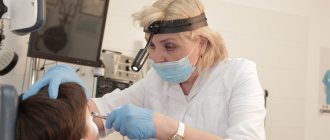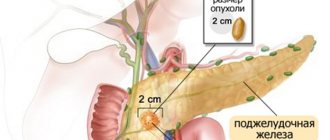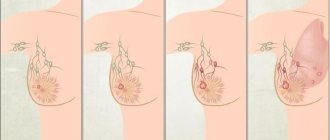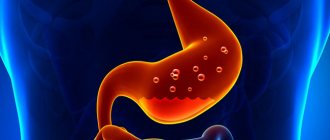The pancreas is an important part of the human digestive system. The production of enzymes that affect digestion and the functioning of the entire body as a whole depends on how this organ functions. Where does the pancreas hurt? When diseases affect the pancreas, a person experiences characteristic pain of severe intensity that occurs in the hypochondrium area. They often acquire an encircling character and are therefore felt everywhere. Everyone needs to know what problems with the pancreas are characterized by.
Pancreatic diseases
The digestion process is impossible without pancreatic juice, which is produced in the pancreas. It has 3 sections - head, body, tail. This gland has a complex structure, and the functions of the organ are very important. Its secretion is involved in the breakdown of proteins, fats, carbohydrates, and it produces the hormones glucagon and insulin.
When the functions of the gland are impaired, serious diseases develop, the most common of which are:
- pancreatitis (acute and chronic);
- autoimmune pancreatitis;
- pancreatic necrosis;
- cyst;
- stones;
- cancer.
The functioning of the organ affects energy metabolism; these diseases can lead to diabetes.
Functions in the body
The pancreas has two fundamentally different functions: exocrine and endocrine. In this regard, there is a complete correlation with the structure of the organ, as we have seen above. Let's look at each of the functions separately.
Exocrine function
The prefix “exo-” translated from Greek means outside, outside. In anatomy, exocrine glands are called glands that have ducts and the secretion of which is released through them into various cavities. In this case, pancreatic juice flows through the pancreatic duct and enters the intestine. Pancreatic juice is a liquid consisting of water, sodium bicarbonates and enzymes. Each of the components has a meaning:
- Sodium bicarbonate is a substance necessary to neutralize the aggressive acidic contents that flow from the stomach into the intestines. The thing is that acid is a damaging factor for the intestinal mucosa. Therefore, when hydrochloric acid as part of a bolus of food enters the intestine, it immediately reacts with the aforementioned bicarbonate and becomes harmless.
- Enzymes refer to special protein structures that break down food components: proteins, fats and carbohydrates. For each of these nutrients, pancreatic juice contains its own enzymes that break them down into simpler compounds. For carbohydrates - amylase, for proteins - trypsin and chymotrypsin, for fats - lipase and phospholipase. This is necessary for the reason that the intestinal mucosa is not able to absorb nutrients in their original form.
- Water is a universal solvent and an ideal medium for the remaining components.
In the absence of bicarbonates, gastric contents would form ulcers in the intestines. A lack of enzymes would lead to the inability to obtain the necessary nutrients and, as a consequence, to various metabolic disorders. It is these processes that occur in the body when the gland duct is blocked by a tumor, a stone, or when most of the organ is destroyed (with chronic pancreatitis).
Why doesn't the pancreas digest itself?
This question is quite reasonable, because pancreatic tissue, like all other organs and like the food we eat, consists of proteins, fats and carbohydrates. However, pancreatic juice enzymes normally do not cause any damage to the gland. The thing is that enzymes are initially secreted in an inactive form. Only after the enzymes in pancreatic juice enter the intestines do they become activated. The enzyme enteropeptidase, produced by the intestinal mucosa, is responsible for this process.
Endocrine function
The prefix “endo-” has the opposite meaning - in, inside. The endocrine part of the pancreas (pancreatic islets) secretes several hormones directly into the blood, the main ones being insulin and glucagon.
The importance of insulin for the body
Insulin is one of the most significant hormones in the human body. The main function of this substance is the distribution of glucose from the blood to organs and tissues. The hormone is produced especially actively in the first few hours after eating.
Figure 2. Functions of insulin in the body. Image: Ismail Jarmouni / Wikipedia (CC BY-SA 4.0)
During the digestion of food, complex carbohydrates are broken down into simple molecules, and glucose is the main product of this process. Glucose is the main energy substrate for almost all cells in the body. Without it entering the cells, their work will stop, just as a steam locomotive will stop without coal. In this comparison, insulin acts as a fireman throwing coal into the firebox of a steam locomotive. In addition to carbohydrates, insulin takes part in fat and protein metabolism. Without this hormone, the synthesis of the body's own proteins and fats is disrupted.
We can talk about the functions of insulin for a long time. However, it is very clear what happens to a person when this hormone is not produced or does not work for other reasons, which happens in patients with diabetes. All organ systems suffer: cardiovascular, immune, nervous - almost all organs are affected by the lack of glucose supply. The exception is the brain, which can take up glucose from the blood even without insulin. But as diabetes progresses, the brain also suffers damage due to vascular damage.
Glucagon and its functions
Glucagon is a complete insulin antagonist. If insulin stimulates the entry of glucose into cells and the synthesis of proteins and fats, then glucagon reverses these processes. The need for this arises during the period of fasting in order to release nutrient reserves into the blood from the depot and thereby constantly maintain a certain concentration in the blood. This is especially true during physical activity to ensure that fatty acids and glucose enter the bloodstream to fuel muscles. Insulin and glucagon are not produced separately; these hormones always work in pairs, clearly regulating metabolic processes in the body.
Symptoms of pancreatic diseases
The first manifestation of the disease is pain in the upper abdomen or left hypochondrium. Discomfort may also be felt in the back and under the left shoulder blade. Due to a violation of the outflow of pancreatic juice, internal edema begins and girdle pain occurs.
Unpleasant sensations intensify after drinking alcohol or overeating, especially fatty and spicy foods. Acute pancreatitis and pancreatic necrosis are characterized by paroxysmal severe pain.
Here are a number of other symptoms of the pancreas in the inflammation stage:
- nausea and vomiting;
- diarrhea;
- bloating and gas;
- weakness;
- yellowness of the skin;
- lack of appetite.
Decreased hormone production disrupts energy metabolism. Signs of diabetes mellitus appear - severe hunger and thirst, dry mouth, increased blood sugar.
Pain Management Clinic Specialists
Shapoval Nikolay Sergeevich Neurologist, Pain Treatment Specialist
Experience: more than 8 years
Details Make an appointment Call a doctor Online consultation
Sinelnikov Konstantin Andreevich Neurologist, Specialist in pain treatment
Experience: more than 10 years
Details Make an appointment Online consultation
Chernenko Valery Yurievich Neurologist, Specialist in pain treatment
Experience: more than 7 years
Details Make an appointment Call a doctor Online consultation
Tyulikov Konstantin Vladimirovich Neurosurgeon, Specialist in pain treatment, Doctor of the highest category, Candidate of Medical Sciences
Experience: more than 14 years
Details Make an appointment
Galperin Mark Yakovlevich Pain treatment specialist at the E. Malysheva clinic, anesthesiologist, algologist
Experience: more than 25 years
Details Make an appointment
Shubin Dmitry Nikolaevich Neurologist, chiropractor, Pain Treatment Specialist at the E. Malysheva Clinic
Experience: more than 30 years
Details Make an appointment
Trushin Pavel Vadimovich Neurosurgeon, Candidate of Medical Sciences
Experience: more than 10 years
Details Make an appointment
Ivanyuk Andrey Genrikhovich Neurologist, reflexologist, doctor of the highest category
Experience: more than 26 years
Details Make an appointment
Causes of pancreatic diseases
A quarter of all cases of acute pancreatitis and pancreatic necrosis occur due to overeating and alcohol abuse. The causes are infections: viral, bacterial, fungal, parasitic.
Scientists have noticed an increasing trend in the incidence of chronic pancreatitis, with a decrease in the average age of patients, from 50 to 39 years. The most common causes of the disease:
- excessive consumption of protein and fatty foods;
- long-term use of a number of medications;
- pathologies of the gastrointestinal tract and liver;
- metabolic disorders;
- developmental anomalies;
- autoimmune diseases.
Acute and chronic pancreatitis lead to the formation of gland cysts - cavities inside which pancreatic juice accumulates. They disrupt digestive functions, cause inflammation and pain.
Pancreatic diseases can be congenital, appearing in infants. They occur in children due to food allergies and genetic disorders (cystic fibrosis, celiac disease).
Causes of pancreatitis
Factors that provoke the onset of the inflammatory process and persistent disruption of the enzymatic function of the pancreas:
- structural defects of the digestive system;
- dyskinesia of the biliary tract and gallbladder;
- severe stress;
- cystic fibrosis;
- hypothyroidism;
- infectious and inflammatory diseases of the gastrointestinal tract;
- intoxication with chemicals;
- parasitic infections;
- mechanical injuries of the abdominal organs as a result of compression, blows, falls;
- long-term use of medications: antibiotics, glucocorticosteroids.
Living in environmentally unfavorable regions and dietary errors can affect the health of the pancreas. The risk of pancreatitis increases consumption of alcohol, refined, fatty foods, fried foods, canned, smoked foods, and overeating.
Complications of self-medication and lack of treatment for pancreatic diseases
Self-treatment of symptoms with painkillers and stomach pills leads to dire consequences. Acute pancreatitis is quickly complicated by the development of infection. Suppuration forms in the organ, and necrosis (death) develops in the gland tissue.
With severe inflammation of the pancreas, the symptoms sharply intensify - respiratory and kidney failure develops, and blood pressure decreases. Chronic pancreatitis can be complicated by the following disorders:
- diabetes;
- hepatitis;
- gastrointestinal bleeding;
- intestinal dysbiosis;
- peritonitis.
If left untreated, pancreatitis and cysts lead to pancreatic cancer. Therefore, self-medication on the Internet or on the advice of pharmacists in a pharmacy is life-threatening.
Treatment of pancreatitis in women
Depending on the type and degree of the disease, the nature of the manifestation of signs of pancreatitis in women, treatment can be carried out in a hospital or on an outpatient basis under the supervision of a gastroenterologist. It includes:
- Drug therapy. Aimed at eliminating symptoms, recovery, as well as preventing possible relapses;
- Preparation of a therapeutic diet by a specialist. It is important to strictly follow the recommendations of the gastroenterologist in order to prevent the development of the disease;
- Invasive intervention. A surgical treatment method is chosen in case of ineffectiveness of drug therapy in advanced acute form of pancreatitis.
Remember that it is important to promptly contact a gastroenterologist when the first signs and symptoms of pancreatitis appear, as this will allow you to select gentle and effective treatment methods.









